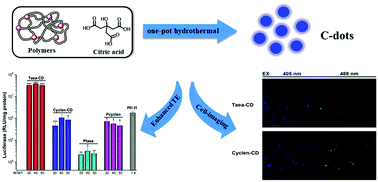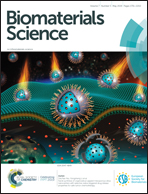Cationic polymer-derived carbon dots for enhanced gene delivery and cell imaging†
Abstract
Carbon dots have attracted rapidly growing interest in recent years. In this report, we prepared two cationic polymer-derived carbon dots (Taea-CD and Cyclen-CD, collectively called C-dots) via a hydrothermal method. Transmission electron microscopy (TEM) results show that the C-dots were sphere-like and the size distribution was 1.8 ± 0.4 nm for Taea-CD and 5.4 ± 2 nm for Cyclen-CD. The C-dots emitted bright blue fluorescence under UV light (365 nm). Confocal laser scanning microscopy (CLSM) assay indicates that the C-dots-mediated transfection process could be detected in real time, and their tunable fluorescence emission under different wavelengths could satisfy varying requirements. Luciferase assay indicates that the transformation from the polymer to CD is an effective strategy to improve the transfection efficiency (TE) of the materials. Moreover, the C-dots also exhibit higher serum tolerance and cell viability than commercially available polyethyleneimine (PEI). These results demonstrate that the preparation of carbon dots from polymers is a promising method for developing multifunctional gene vectors with high TE and biocompatibility.



 Please wait while we load your content...
Please wait while we load your content...